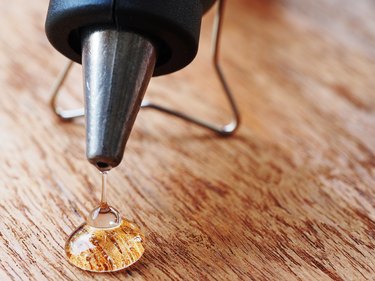
Hot glue in a glue gun is a versatile tool used by crafters of all types. But when this quick-drying glue ends up in unintended places -- such as fabric -- it becomes problematic. When that glue dries on the fabric, removal can seem impossible. While it's no cakewalk, you can remove hot glue from fabric with common household items.
Things You'll Need
Spoon or butter knife
Iron
Brown paper bag
Rubbing alcohol
Small container
Cotton swabs
Cloth
Acetone
Cotton balls
Video of the Day
Using the Freezer Method
If your garment or piece of cloth is small enough, freezing it can often be the simplest method.
Video of the Day
Step 1: In the Freezer
Place the fabric with the dried hot glue in the freezer. Let the fabric sit in the freezer for 30 minutes to an hour.
Step 2: Hard Surface
Remove the fabric from the freezer and place on a hard surface with the now-hardened and cold glue facing up.
Step 3: Remove the Glue
Remove the dried glue carefully from the fabric by scraping it or popping it off with a spoon or butter knife. If the spoon won't scrape it off, work a knife between the fabric and the glue to gently remove it.
Warning
Apply caution as you scrape the glue from the fabric to avoid ripping the material.
Using the Iron Method
The iron method transfers the glue from the fabric to another source, such as a paper bag or cotton cloth. Either will work for this method.
Step 1: Preheat Iron
Preheat an iron on its medium-to-high setting or for the type of fabric. Do not use the steam setting. Place the fabric on a hard surface – such as an ironing board – with the dried glue facing up.
Step 2: Bag It
Cover the dried glue with a brown paper bag or a cotton cloth. Hold the iron directly on top of the paper bag, pressing for about 20 seconds. Lift the iron from the paper bag.
Step 3: Examine the Fabric
Lift the brown paper bag up carefully to examine your progress. If there is still dried hot glue on the fabric, reposition the paper bag so that a clean area covers the glue. Press the iron on top of the bag and hold for another 10 to 20 seconds. Repeat the process until the dried glue is gone.
Warning
Pay attention to the glue transfer. The iron heats up the glue to make it soft enough to transfer to the bag or cotton cloth. Don't overheat the glue so that it melts into the fabric. Adjust the iron to the setting for the fabric.
Using the Rubbing Alcohol Method
Step 1: Set-up the Rubbing Alcohol
Pour a small amount of rubbing alcohol into a container. Dip the head of a cotton swab in the rubbing alcohol until it is damp.
Step 2: Rub the Dried Glue
Rub the dried glue with the dampened cotton swab. Continue rubbing until the alcohol breaks the bond between the glue and the fabric. If necessary, re-dampen the cotton swab with rubbing alcohol.
Step 3: Blot the Fabric
Blot the area with a cloth dampened with water once you have removed the dried hot glue. Launder the fabric as you normally would.
Using the Acetone Method
Step 1: Lay Out the Fabric
Lay the fabric – glue side facing up – on a hard surface.
Step 2: Cotton Ball
Remove the cap from the acetone bottle. Hold the cotton ball on top of the bottle so that it covers the opening completely. Carefully turn the bottle upside down so that the acetone dampens the cotton ball.
Step 3: Apply Acetone
Dab the dried glue with the dampened cotton ball. Continue dabbing until you have removed the glue. Rinse the acetone off the fabric with cool water.
Tip
If necessary, use one or more removal methods in conjunction with another one until you have removed the hot glue from the fabric.
Warning
Acetone can damage nylon and other synthetic fabrics, so apply with caution.